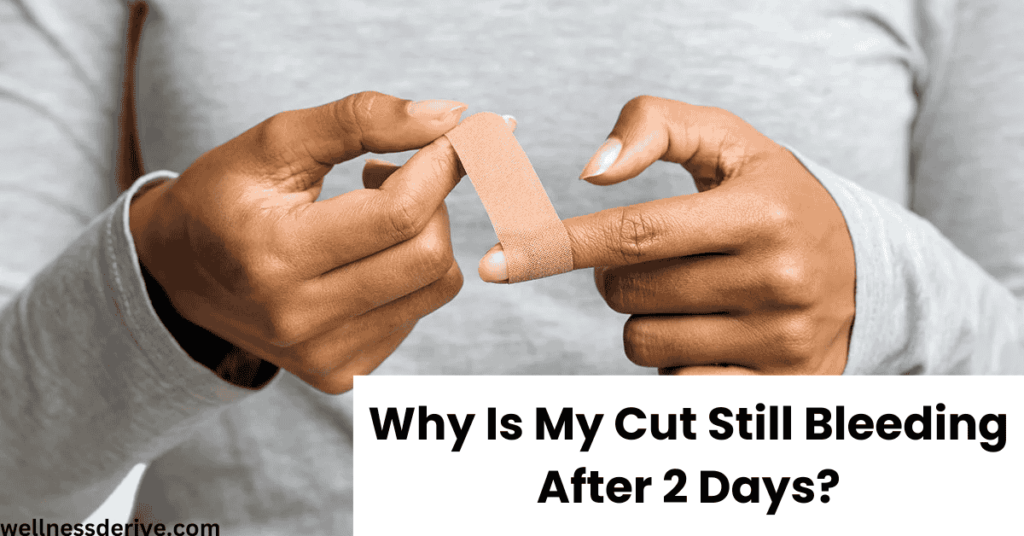A minor cut or scrape usually clots and begins to heal within a few hours. But if you’ve found yourself wondering, “Why is my cut still bleeding after 2 days?”, you’re not alone. Prolonged bleeding can signal that something isn’t quite right—and in some cases, it could require medical attention.
This article explores the potential reasons why your cut is still bleeding, what signs to watch for, how to manage excessive bleeding, and when it’s time to see a doctor.
What Does It Mean When a Cut Won’t Stop Bleeding?
In most cases, small cuts start to clot and dry within minutes. So, if a small cut is still bleeding after 24 hours, or especially after 48 hours, it may indicate:
- Delayed clotting due to underlying health conditions
- Infection preventing proper healing
- Poor wound care or re-exposure to bacteria
- Use of certain medications (e.g., blood thinners or NSAIDs)
- Hidden injury to deeper tissues or small blood vessels
If you’re thinking, “What does a cut bleeding mean this long?”, it may be your body’s way of saying the wound isn’t healing as expected.
Common Reasons a Cut May Still Bleed After 2 Days
1. Inadequate Initial Wound Care
Not cleaning the wound properly right after injury can lead to complications. Dirt, bacteria, or foreign materials may linger, preventing the clotting process.
- Tip: Always clean a fresh cut with mild soap and water and cover it with a sterile bandage.
2. Continuous Reopening of the Wound
If you’re moving the affected area frequently, the wound may reopen and bleed. Even a tiny spot that won’t stop bleeding could be the result of mechanical stress.
- Example: Cuts on joints or fingers tend to reopen due to movement.
3. Underlying Medical Conditions
Health issues such as diabetes, liver disease, or clotting disorders can delay healing. These can also result in excessive bleeding from a small cut.
- Note: If you’re immunocompromised, even minor cuts need closer attention.
4. Medication Side Effects
Medications like aspirin, NSAIDs, corticosteroids, or anticoagulants may impair clotting.
- Advice: If your cut won’t stop bleeding and you’re on such medications, contact your doctor.
5. Infection
When bacteria invade the wound, your immune response may interfere with the clotting process. Watch for signs such as:
- Redness or swelling
- Warmth around the wound
- Pus or cloudy fluid
- Foul odor
How Long Should a Cut Bleed?
Most minor cuts stop bleeding within 10 to 15 minutes with proper pressure. If your cut is still bleeding after 2 hours, that’s a warning sign. Continuous bleeding beyond 6 hours, 24 hours, or 2 days may suggest a deeper issue.
For example:
- A cut still bleeding after 6 hours might indicate hidden blood vessel damage.
- A wound still bleeding after a week is not normal and requires immediate medical review.
What Should You Do If Blood Seeps Through a Dressing?
If you’re using gauze or a bandage and notice blood seeping through:
- Do NOT remove the original bandage.
- Apply another clean dressing on top.
- Continue applying firm, direct pressure for 10-15 minutes.
- Elevate the wounded area above the heart if possible.
If bleeding continues, seek professional medical help.
How to Treat a Cut That Won’t Stop Bleeding
First Aid Steps:
- Clean the wound gently with soap and water.
- Apply pressure with a clean cloth or gauze.
- Use antiseptic spray to reduce infection risk.
- Cover with a clean, sterile bandage.
- Consider using a bleed stop stick or clotting agent for minor wounds.
- Avoid checking under the bandage too soon, which can disrupt clotting.
What NOT to Do:
- Don’t remove any embedded objects—seek medical help instead.
- Don’t touch the wound with unclean hands or tools.
- Don’t apply hydrogen peroxide or alcohol directly (it may slow healing).
Remedies for Prolonged Bleeding
If you experience prolonged bleeding, consider these simple but effective remedies:
1. Cold Compress
Apply a cold compress or ice pack near the wound for 10–15 minutes. This helps constrict blood vessels and slow down the bleeding naturally.
2. Antiseptic Solutions
Gently clean the area using an antiseptic solution like hydrogen peroxide or iodine. This reduces the risk of infection, which can delay clotting and prolong bleeding.
3. Healthy Diet
Eat foods rich in vitamin K (like spinach and kale), iron (like lentils and red meat), and protein to support tissue repair and blood clotting mechanisms.
4. Rest the Affected Area
Avoid unnecessary movement or pressure on the injured area. Resting helps prevent the wound from reopening and allows clotting to stabilize.
When to Seek Medical Help
Contact a doctor or visit urgent care if:
- Your cut bleeds for more than 20 minutes despite pressure
- There’s persistent bleeding after 2–3 days
- You see signs of infection
- The wound is deep, jagged, or caused by an animal
- You have a chronic condition like diabetes
Also, if you haven’t had a tetanus shot in the last 5–10 years, and the wound is from a puncture or rusty object, get one as soon as possible.
How to Prevent a Cut From Bleeding Again
- Avoid physical strain on the injured area
- Use advanced bandages (like hydrocolloid dressings) that create a moisture-sealed barrier
- Keep the wound clean and dry
- Don’t pick at scabs
- Follow your physician’s aftercare instructions
FAQs: Why Is My Cut Still Bleeding After 2 Days?
Conclusion
If you’re asking, “Why is my cut still bleeding after 2 days?”, it’s time to pay close attention. While most small injuries heal quickly, prolonged bleeding can point to improper wound care, underlying conditions, or infection.
By recognizing the signs early, taking the right first aid steps, and knowing when to seek medical help, you can avoid complications and support faster healing. When in doubt—especially if your cut won’t stop bleeding—don’t hesitate to contact a healthcare provider.
Disclaimer: The content on Wellness Derive is for informational purposes only and not a substitute for professional medical advice, diagnosis, or treatment. Always consult a healthcare provider for medical concerns.



